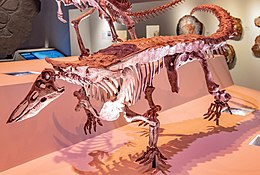
Back أيتوصوريات Arabic Etosaures Catalan Aetosauria Czech Aetosauria German Aetosauria Spanish اتوسور Persian Aetosauria Finnish Aetosauria French אטוזאורים HE Aetosauria Hungarian
| Aetosaurs Temporal range: Late Triassic,
| |
|---|---|

| |
| Skeletal mount of Desmatosuchus | |
| Scientific classification | |
| Domain: | Eukaryota |
| Kingdom: | Animalia |
| Phylum: | Chordata |
| Class: | Reptilia |
| Clade: | Archosauria |
| Clade: | Pseudosuchia |
| Clade: | †Aetosauriformes |
| Order: | †Aetosauria Lydekker, 1887 |
| Subgroups | |
| |
Aetosaurs (/eɪˌɛtoʊˈsɔːr/) are heavily armored reptiles belonging to the extinct order Aetosauria (/eɪˌɛtoʊˈsɔːriə/; from Greek, ἀετός (aetos, "eagle") and σαυρος (sauros, "lizard")). They were medium- to large-sized omnivorous or herbivorous pseudosuchians, part of the branch of archosaurs more closely related to crocodilians than to birds and other dinosaurs. All known aetosaurs are restricted to the Late Triassic, and in some strata from this time they are among the most abundant fossil vertebrates. They have small heads, upturned snouts, erect limbs, and a body ornamented with four rows of plate-like osteoderms (bony scutes). Aetosaur fossil remains are known from Europe, North and South America, parts of Africa, and India. Since their armoured plates are often preserved and are abundant in certain localities, aetosaurs serve as important Late Triassic tetrapod index fossils. Many aetosaurs had wide geographic ranges, but their stratigraphic ranges were relatively short. Therefore, the presence of particular aetosaurs can accurately date a site in which they are found.[1][2][3]
Nearly all aetosaurs (except for the genus Aetosauroides) belong to the family Stagonolepididae. Over 20 genera of aetosaurs have been described, and recently there has been controversy regarding the description of some of these genera. Two distinct subdivisions of aetosaurs are currently recognized, Desmatosuchia and Aetosaurinae, based primarily on broad differences in skull morphology.[4] Osteoderms structure is generally one of the most useful traits for inferring aetosaur relations more precisely. Among other archosaurs, aetosaurs are most closely related to Revueltosaurus, a small reptile originally known from teeth mistakenly referred to herbivorous dinosaurs.[3]
Aetosaur remains were first discovered in the early 19th century, although the first remains that were described were mistaken for fish scales. Aetosaurs were later recognized as crocodile relatives, at which point they were interpreted as semiaquatic scavengers closely related to phytosaurs. Subsequent work has established that aetosaurs were entirely terrestrial animals, and were likely herbivorous to some extent. Some forms have characteristics that may have been adaptations to digging for food. Supposed nesting structures have also been referred to aetosaurs, but this connection is considered ambiguous.[3]
- ^ Heckert, A. B.; Lucas, S. G. (2002). "South American occurrences of the Adamanian (Late Triassic: Latest Carnian) index taxon Stagonolepis (Archosauria: Aetosauria) and their biochronological significance". Journal of Paleontology. 76 (5): 852–863. doi:10.1666/0022-3360(2002)076<0852:SAOOTA>2.0.CO;2. ISSN 0022-3360. S2CID 128610620.[permanent dead link]
- ^ Lucas, S. G. (1998). "Global Triassic tetrapod biostratigraphy and biochronology". Palaeogeography, Palaeoclimatology, Palaeoecology. 143 (4): 347–384. Bibcode:1998PPP...143..347L. CiteSeerX 10.1.1.572.872. doi:10.1016/S0031-0182(98)00117-5.
- ^ a b c Cite error: The named reference
Detal13was invoked but never defined (see the help page). - ^ Cite error: The named reference
:0was invoked but never defined (see the help page).